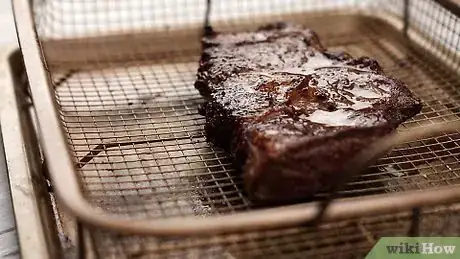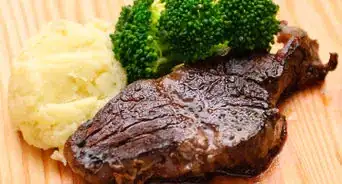This article was co-authored by Marrow Private Chefs. Marrow Private Chefs are based in Santa Rosa Beach, Florida. It is a chefs’ collaborative comprised of an ever-growing number of chefs and culinary professionals. Though regionally influenced primarily by coastal, traditional southern, cajun, and creole styles and flavors, the chefs at Marrow have a solid background in all types of cuisine with over 75 years of combined cooking experience.
There are 7 references cited in this article, which can be found at the bottom of the page.
wikiHow marks an article as reader-approved once it receives enough positive feedback. In this case, several readers have written to tell us that this article was helpful to them, earning it our reader-approved status.
This article has been viewed 948,349 times.
A great beefsteak with a crispy outer crust and tender interior starts with the right seasoning. Steak seasoning technique involves accurate timing and even meat coverage. To achieve a flavorful coating, use a blend of spices and oil.
Steps
Using Basic Seasoning
-
1Let your steak reach room temperature. Pat your steak dry with paper towels and allow it to come to room temperature during the seasoning process. Yes, it takes a little extra time to get the finished product, but when that finished product is more tender, is juicier, and boasts a quicker cooking time, the extra time is well worth it.
- Why let the steak come to room temperature before cooking? First, a steak that has come to room temperature will cook more evenly.[1] You won't have a hot exterior and a chilly interior. Second, the steak will cook quicker. This means less time on the grill, or the frying pan, or in the oven, and more time spent sipping wine.
- Will letting your steaks come to room temperature affect their taste or make the cuts go bad? No. Letting a steak sit for 30 to 60 minutes shouldn't affect the taste or smell of the meat, and will not cause the meat to go bad. More bacteria will multiply the longer you let it sit out[2] , but those bacteria will be killed on contact with proper heat.
-
2Season your steak with about ¾ - 1 teaspoon of salt per pound, applying on both sides. Since you obviously cannot "salt to taste," it's sometimes hard to know how much salt is enough. Many chefs recommend this benchmark as a good guide for pre-seasoning meat.[3]
- Salt your steak at least 40 minutes before you cook it. Most cooks salt their steaks right before placing it on the grill. Because salt is a desiccant, this draws the moisture out to the surface of the steak, where it gets seared off immediately. This produces mostly an underwhelming steak. Instead of seasoning with salt right before you place it on the grill, salt at least 40 minutes to an hour ahead of time. This allows the moisture to return into the steak as well as tenderize the meat.
- When you salt at least 40 minutes in advance of cooking, the moisture drawn out to the surface by the salt has time to seep back into the meat.[4] This process is called osmosis, and it happens very slowly, which is why it takes time. The moisture that travels back into the steaks is now well-salted and flavorful.
- This salting process also tenderizes the meat by breaking down proteins. Broken-down proteins mean a softer, more succulent steak.
Advertisement -
3After your steak has come to room temperature and been salted well enough in advance, brush a small amount of oil over its surface. Olive oil has a distinct, crisp flavor that many cooks love, although you might prefer a more neutral oil, such as groundnut or canola oil. Use no more than a teaspoon for each pound of meat.
-
4Decide whether to apply pepper before or after you cook your steak. Many chefs prefer to season their steaks after they've finished cooking them because pepper can char while cooking and impart a slightly burned flavor. Some chefs don't worry about charring, believing it to give the steaks a heartier flavor. Experiment with both methods and see which one turns out best for you.
- For the best flavor, grind your peppercorns yourself in a pepper mill immediately before use. Do not buy pre-ground pepper, as it will get stale. Freshly-ground pepper makes a world of difference.
-
5Allow good meat to speak for itself. Great-tasting cuts of steak don't need fancy seasonings or marinades to taste good. In fact, great-tasting cuts of steak probably taste worse-off after a complex bath of herbs, aromatics, and spices. If you're frying a nice T-bone or porterhouse, or grilling a filet-mignon, stick with nice and simple for best results.
Using Different Seasoning Combinations
-
1Make your own Montreal Steak Seasoning.[5] Montreal steak seasoning is perhaps the most classic steak seasoning, strong enough to enhance the flavor of the meat yet delicate enough not to overpower it. Chances are you already have most of the ingredients in your own pantry, so why not try to make it yourself? Combine:
- 2 tablespoons crushed black pepper
- 2 tablespoons kosher salt
- 1 tablespoons paprika
- 1 tablespoon granulated garlic
- 1 tablespoon granulated onion
- 1 tablespoon crushed coriander
- 1 tablespoon dill
- 1 tablespoon crushed red pepper flakes
-
2Try something out of the ordinary with a turmeric-based spice blend.[6] Extensively used in South-Asian cuisine, turmeric is a yellow spice that is actually part of the ginger family. If you want to give your steak a not-so-average rub, try this flavorful blend of spices and seasonings:
- 4 teaspoons salt, or to taste
- 2 teaspoons paprika
- 1 1/2 teaspoons ground black pepper
- 3/4 teaspoon onion powder
- 3/4 teaspoon garlic powder
- 3/4 teaspoon cayenne pepper
- 3/4 teaspoon ground coriander
- 3/4 teaspoon ground turmeric
-
3Try a seasoning or "rub" that involves a little bit of ground coffee.[7] Coffee is both aromatic and tasty, and believe it or not, it makes a fantastic seasoning. This seasoning has a little bit of everything in it — heat, spice, sweetness, and tang:
- 1 tablespoon kosher salt
- 1 tablespoon ground black pepper
- 1 tablespoon ground coriander
- 2 teaspoons mustard powder
- 2 teaspoons ground coffee
- 1 teaspoon unsweetened cocoa powder
- ½ teaspoon ancho chili powder
- ½ teaspoon ground cinnamon
- ½ teaspoon ground cloves
- ⅛ teaspoon cayenne pepper
Cooking Your Steak
-
1Grill your steak. Grilling is the quintessential summer cooking method. Grab a few beers, heat up the barbecue, and get at it. If you can, make sure to use charcoal instead of gas, and for goodness sake, make sure your grill has different heat stations for best results!
-
2Pan-fry your steak. Probably a little less fussy than grilling, pan-frying allows you to get your steak out of the refrigerator and into your stomach in record time. Although pan-frying is less healthy than oven-roasting or grilling, some contend that nothing's better than a fresh fried steak.
-
3Broil your steak in the oven. Heat up your broiler for a healthier and no-nonsense steak. Cooking over high heat makes this method a little more risky than other methods if you're after medium-rare meat, but with the right technique, broiled steak often tastes unparalleled.
-
4Cook a steak with in the pan and the oven. Start your steak off in the pan and end it in the oven for a ridiculously juicy steak that's crisp and brown on the outside and succulent on the inside.
References
- ↑ http://www.seriouseats.com/2011/03/the-food-lab-more-tips-for-perfect-steaks.html
- ↑ http://www.amazingribs.com/tips_and_technique/mythbusting_letting_meat_come_to_room_temp.html
- ↑ http://www.thekitchn.com/how-and-why-to-preseason-your-78902
- ↑ http://www.steamykitchen.com/163-how-to-turn-cheap-choice-steaks-into-gucci-prime-steaks.html
- ↑ http://www.chow.com/recipes/10590-montreal-steak-seasoning
- ↑ http://allrecipes.com/recipe/rocks-t-bone-steaks/
- ↑ http://www.everydaymaven.com/2013/cowboy-seasoning-rub-for-beef/
Expert Q&A
-
QuestionHow do you season a steak really good?
 Marrow Private ChefsMarrow Private Chefs are based in Santa Rosa Beach, Florida. It is a chefs’ collaborative comprised of an ever-growing number of chefs and culinary professionals. Though regionally influenced primarily by coastal, traditional southern, cajun, and creole styles and flavors, the chefs at Marrow have a solid background in all types of cuisine with over 75 years of combined cooking experience.
Marrow Private ChefsMarrow Private Chefs are based in Santa Rosa Beach, Florida. It is a chefs’ collaborative comprised of an ever-growing number of chefs and culinary professionals. Though regionally influenced primarily by coastal, traditional southern, cajun, and creole styles and flavors, the chefs at Marrow have a solid background in all types of cuisine with over 75 years of combined cooking experience.
Private Chefs The short answer is salt and pepper—if you have a fresh, good quality cut of meat, this is all you need to bring the best flavor out of it. However, if you're feeling more adventurous, there are thousands of steak seasoning blends on the market that you can likely find at your local grocery store.
The short answer is salt and pepper—if you have a fresh, good quality cut of meat, this is all you need to bring the best flavor out of it. However, if you're feeling more adventurous, there are thousands of steak seasoning blends on the market that you can likely find at your local grocery store. -
QuestionIs Italian dressing good for marinating steaks?
 Linda DeBenedittisCommunity AnswerI have used it for Chicken before and it was very good, so I think it would be good on steak too. Most Italian dressings contain oil and some kind of acidic liquid (some kind of vinegar or lemon juice) and seasonings, all of which makes for a good marinade.
Linda DeBenedittisCommunity AnswerI have used it for Chicken before and it was very good, so I think it would be good on steak too. Most Italian dressings contain oil and some kind of acidic liquid (some kind of vinegar or lemon juice) and seasonings, all of which makes for a good marinade. -
QuestionDo I season my steak with vinegar?
 Community AnswerWhile you can use it to marinade a steak, most people use olive oil, salt, pepper, and garlic powder. It's up to you as to how you want your steak to be flavored.
Community AnswerWhile you can use it to marinade a steak, most people use olive oil, salt, pepper, and garlic powder. It's up to you as to how you want your steak to be flavored.
Warnings
- Raw beef may host bacterial growth. Wash your hands after handling and seasoning uncooked steak to prevent accidental ingestion or contamination of other foods and utensils.⧼thumbs_response⧽
- Wet meat won't form a crust when cooking. If your steak becomes moist while resting, pat it dry again before oiling and re-seasoning it.⧼thumbs_response⧽
Things You'll Need
- Salt
- Pepper
- Oil
- Large plate
- Wire rack
About This Article
To season a steak, start by letting it come to room temperature, which will help it cook more evenly. Next, sprinkle salt on both sides of the steak at least 40 minutes before you cook it so it has time to tenderize the meat. When you're ready to cook the steak, brush it with a little bit of oil and season both sides with pepper. You can also use other seasonings like garlic powder, paprika, chili powder, and turmeric. After you finish seasoning the steak, it's ready to be cooked. If you want to learn how to cook your steak after it's been seasoned, keep reading the article!





























































